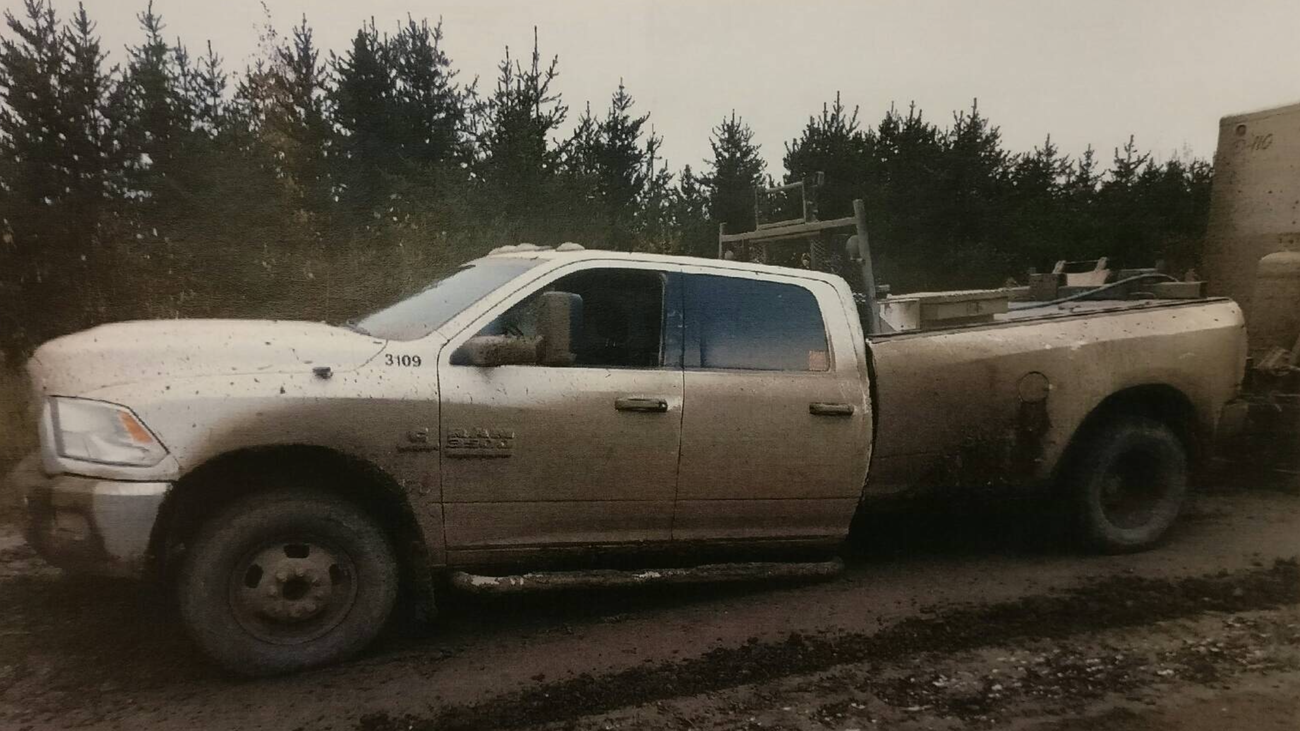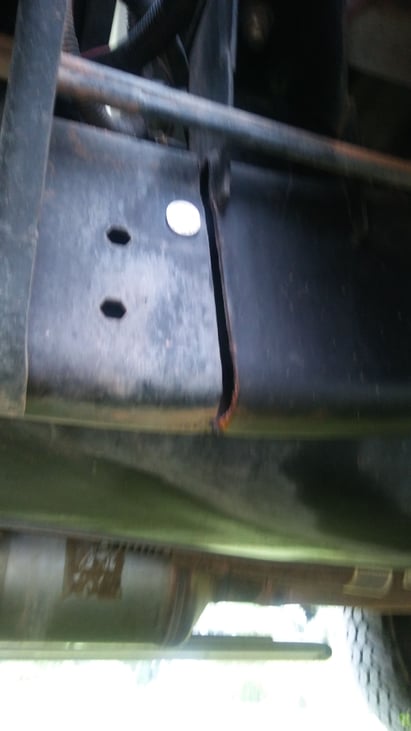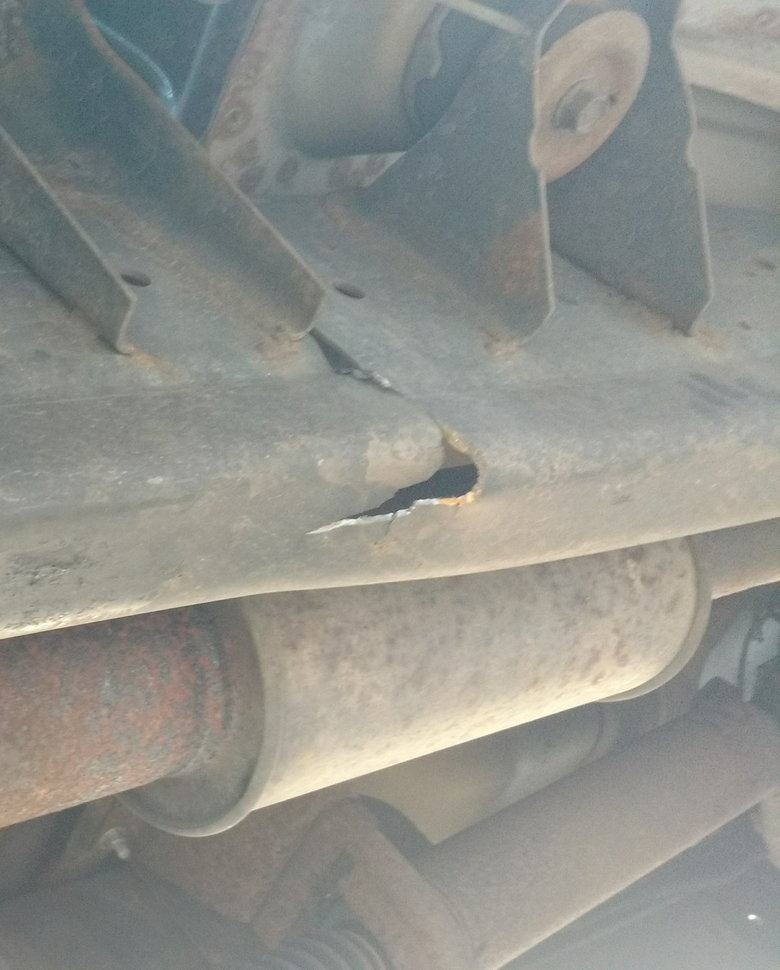- Good Sam Community
- Groups
- Travel Trailer Group
- Forum
- Re: Broken Frame on a RAM 3500
- Subscribe to RSS Feed
- Mark Topic as New
- Mark Topic as Read
- Float this Topic for Current User
- Bookmark
- Subscribe
- Mute
- Printer Friendly Page
Broken Frame on a RAM 3500
- Mark as New
- Bookmark
- Subscribe
- Mute
- Subscribe to RSS Feed
- Permalink
- Report Inappropriate Content
Dec-29-2022 07:09 PM
Here's an article about it that was published earlier today.
Broken Frame on a RAM 3500
2018 Arctic Fox 992 with an Onan 2500i "quiet" model generator
- Labels:
-
Truck Campers
- Mark as New
- Bookmark
- Subscribe
- Mute
- Subscribe to RSS Feed
- Permalink
- Report Inappropriate Content
Jan-06-2023 08:02 AM



*Set width tag to 640 pixels
Sold: 2016 Arctic Fox 990, 2018 Ram 3500, 2011 Open Range
Sold Forest River Forester 2401R Mercedes Benz. when campsites went from $90 to $190 per night.
- Mark as New
- Bookmark
- Subscribe
- Mute
- Subscribe to RSS Feed
- Permalink
- Report Inappropriate Content
Jan-06-2023 07:32 AM
bucky wrote:
I'm thinking this guy just read this and other threads on the interweb.
TC for sale
Big difference between an 1130 and that huge eagle cap, that setup is fine all day long on a dually. Doubt that guy is selling due to reading about this issue.
2008 Lance 1191 - 220w of solar - Bring on the sun!
- Mark as New
- Bookmark
- Subscribe
- Mute
- Subscribe to RSS Feed
- Permalink
- Report Inappropriate Content
Jan-06-2023 07:16 AM
FishOnOne wrote:Grit dog wrote:
No, mkirsch is just being a little dramatic or critical of some previous uninformed comments. Of which rvnet has no lack of.
The big takeaway from this whole thing is ratings are (sometimes) there for a real physical limitation reason. You know, something based on engineering principle and design. Other ratings are given similarly but with large factors of safety not explicitly mentioned. And yet others are in place for only regulatory reasons.
That’s why the old adage of “stick to the ratings” if you can’t understand or discern from the above is always the “safe” bet.
But sometimes “safe” or in many cases overly safe costs alot of unnecessary money. And if one can understand or get some good advice that is cheaper than spending cubic dollars to be “overly safe.”
In the case of this truck. This is the largest capacity rating on a given design (light duty pickup chassis). It seems obvious to me but should stand to reason to anyone with some knowledge that if the same thing is rated less here and more there, that the more rating has a lower factor of safety.
And this guy found out what that limit is for his frame!
On the upside like mkirsch has been ranting about , this failure totally supports the arguments that your not going to break that frame, springs or axle on your 2500 Ram (or whatever 3/4 ton) by exceeding the paltry regulatory based rating by a large margin.
Mkirsch is doing a disservice by trying to lump ALL comments into the same bucket.
Could be a manufacturing defect. We've already seen a recall from Ram that required rewelding the brackets on the front end of the frame and who knows if the steel used to make this frame met strength requirements.
Sure could be. All mfgs have defects and the subject of this thread could have also been a defect that ate into the factor of safety enough that being whatever 30% overloaded and running the Baja at the same time caused a failure. Even that dude had 25k good miles on the setup before failure.
I’ve had factory defects in all of the big 3 trucks.
Between work and personal rigs since the early 90s I’ve had probably 2 dozen Fords, around 10 GMs and 7 Dodge/Rams. I’ve also had zero frame failures on any truck and in an industry with fleets of 1000s of light duty trucks that are subject to stupid human tricks regularly (myself included) this isn’t really a “thing” from any mfg.
08 Ford 150 total lemon, wasn’t used to tow heavy at all. The list was long including a physically grenaded trans and almost burned down on the side of the road.
05 F150 ate injectors for breakfast.
2001 Dodge 1500 2 defective 3rd members that rendered the truck undriveabale both times within 1000mi of new.
2016 Silverado 1500. Beat it like a rented mule towing sometimes. 14klb trailers over Mtn passes. Trans was defective from day 1. Chevy dealer didn’t see it that way. Yet it lasted 60k miles and trans replaced under warranty.
For someone with a broader experience across the board with all 3 brands and more miles than most as well, all 3 mfg are relatively trouble free.
The biggest nickel and dimer was actually my 07 Dodge 5.9 diesel.
And the best was the 02 Duramax.
2017 Heartland Torque T29 - Sold.
Couple of Arctic Fox TCs - Sold
- Mark as New
- Bookmark
- Subscribe
- Mute
- Subscribe to RSS Feed
- Permalink
- Report Inappropriate Content
Jan-06-2023 07:03 AM
bucky wrote:
I'm thinking this guy just read this and other threads on the interweb.
TC for sale
Lol, that’s funny! Would have been funnier if it was sitting on a Dodge!
2017 Heartland Torque T29 - Sold.
Couple of Arctic Fox TCs - Sold
- Mark as New
- Bookmark
- Subscribe
- Mute
- Subscribe to RSS Feed
- Permalink
- Report Inappropriate Content
Jan-06-2023 02:51 AM
- Mark as New
- Bookmark
- Subscribe
- Mute
- Subscribe to RSS Feed
- Permalink
- Report Inappropriate Content
Jan-05-2023 01:48 PM
Bigfoot affair wrote:
IDK, I would suspect the frame to be the last thing to fail when over loaded. Tires/wheels first, then axle followed by springs etc. Had my 03 GMC 2500 overloaded with my Bigfoot camper and boat for many years with no failures.
More RAM frame failures Broken frames
Several times (3 Fords, 1 Dodge, and 2 GM) overloaded class 3 trucks, the failure that stops use has been rear lug studs. Few times, the wheels where damaged, but can't swear it was not because studs where braking, putting extra stress around holes still holding.
- Mark as New
- Bookmark
- Subscribe
- Mute
- Subscribe to RSS Feed
- Permalink
- Report Inappropriate Content
Jan-05-2023 01:23 PM
More RAM frame failures Broken frames
- Mark as New
- Bookmark
- Subscribe
- Mute
- Subscribe to RSS Feed
- Permalink
- Report Inappropriate Content
Jan-05-2023 12:47 PM
Grit dog wrote:
No, mkirsch is just being a little dramatic or critical of some previous uninformed comments. Of which rvnet has no lack of.
The big takeaway from this whole thing is ratings are (sometimes) there for a real physical limitation reason. You know, something based on engineering principle and design. Other ratings are given similarly but with large factors of safety not explicitly mentioned. And yet others are in place for only regulatory reasons.
That’s why the old adage of “stick to the ratings” if you can’t understand or discern from the above is always the “safe” bet.
But sometimes “safe” or in many cases overly safe costs alot of unnecessary money. And if one can understand or get some good advice that is cheaper than spending cubic dollars to be “overly safe.”
In the case of this truck. This is the largest capacity rating on a given design (light duty pickup chassis). It seems obvious to me but should stand to reason to anyone with some knowledge that if the same thing is rated less here and more there, that the more rating has a lower factor of safety.
And this guy found out what that limit is for his frame!
On the upside like mkirsch has been ranting about , this failure totally supports the arguments that your not going to break that frame, springs or axle on your 2500 Ram (or whatever 3/4 ton) by exceeding the paltry regulatory based rating by a large margin.
Mkirsch is doing a disservice by trying to lump ALL comments into the same bucket.
Could be a manufacturing defect. We've already seen a recall from Ram that required rewelding the brackets on the front end of the frame and who knows if the steel used to make this frame met strength requirements.
'16 Sprinter 319MKS "Wide Body"
- Mark as New
- Bookmark
- Subscribe
- Mute
- Subscribe to RSS Feed
- Permalink
- Report Inappropriate Content
Jan-04-2023 10:53 AM
The big takeaway from this whole thing is ratings are (sometimes) there for a real physical limitation reason. You know, something based on engineering principle and design. Other ratings are given similarly but with large factors of safety not explicitly mentioned. And yet others are in place for only regulatory reasons.
That’s why the old adage of “stick to the ratings” if you can’t understand or discern from the above is always the “safe” bet.
But sometimes “safe” or in many cases overly safe costs alot of unnecessary money. And if one can understand or get some good advice that is cheaper than spending cubic dollars to be “overly safe.”
In the case of this truck. This is the largest capacity rating on a given design (light duty pickup chassis). It seems obvious to me but should stand to reason to anyone with some knowledge that if the same thing is rated less here and more there, that the more rating has a lower factor of safety.
And this guy found out what that limit is for his frame!
On the upside like mkirsch has been ranting about , this failure totally supports the arguments that your not going to break that frame, springs or axle on your 2500 Ram (or whatever 3/4 ton) by exceeding the paltry regulatory based rating by a large margin.
Mkirsch is doing a disservice by trying to lump ALL comments into the same bucket.
2017 Heartland Torque T29 - Sold.
Couple of Arctic Fox TCs - Sold
- Mark as New
- Bookmark
- Subscribe
- Mute
- Subscribe to RSS Feed
- Permalink
- Report Inappropriate Content
Jan-04-2023 10:38 AM
mkirsch wrote:JimK-NY wrote:mkirsch wrote:
Now all of a sudden everybody's a weight police. "Oh he was 10lbs over GVWR! That's why his frame broke!"
Did you notice the post from someone with the same truck? CCC is 4738#. The owner of the broken truck had a camper with a base weight of 5000#. Water and propane bring that to 5500#. Accessories are not included. We can see solar, awnings and a roof rack. I can't see if there is an A/C unit or a generator neither are in the base weight. At a minimum the weight will be 6000#. That does not include the bikes or rack, tools, kitchen gear, food, bedding, air compressor and personal items very likely totally well over 1000#. Best guess is this unit was in the range of 7000-7500# or roughly 2500-3000# over the CCC. In addition there is clearly an issue with center of gravity.
Sadly beginners and often experienced truck camper users often fail to realize how heavy their rigs are.
"Conventional wisdom" on this forum is, NONE OF THAT MATTERS! Axle's rated for 11K! Nobody's ever broken a frame!
Telling someone they needed a 4500-5500 class truck to carry a camper like that got you ostracized as a worry wart, weight police, fun-hating SQUARE.
This thread just oozes with HYPOCRISY.
DING DING DING, we have a winner! This is so true.
- Mark as New
- Bookmark
- Subscribe
- Mute
- Subscribe to RSS Feed
- Permalink
- Report Inappropriate Content
Jan-04-2023 07:56 AM
2017 Heartland Torque T29 - Sold.
Couple of Arctic Fox TCs - Sold
- Mark as New
- Bookmark
- Subscribe
- Mute
- Subscribe to RSS Feed
- Permalink
- Report Inappropriate Content
Jan-04-2023 05:48 AM
JimK-NY wrote:mkirsch wrote:
Now all of a sudden everybody's a weight police. "Oh he was 10lbs over GVWR! That's why his frame broke!"
Did you notice the post from someone with the same truck? CCC is 4738#. The owner of the broken truck had a camper with a base weight of 5000#. Water and propane bring that to 5500#. Accessories are not included. We can see solar, awnings and a roof rack. I can't see if there is an A/C unit or a generator neither are in the base weight. At a minimum the weight will be 6000#. That does not include the bikes or rack, tools, kitchen gear, food, bedding, air compressor and personal items very likely totally well over 1000#. Best guess is this unit was in the range of 7000-7500# or roughly 2500-3000# over the CCC. In addition there is clearly an issue with center of gravity.
Sadly beginners and often experienced truck camper users often fail to realize how heavy their rigs are.
"Conventional wisdom" on this forum is, NONE OF THAT MATTERS! Axle's rated for 11K! Nobody's ever broken a frame!
Telling someone they needed a 4500-5500 class truck to carry a camper like that got you ostracized as a worry wart, weight police, fun-hating SQUARE.
This thread just oozes with HYPOCRISY.
Putting 10-ply tires on half ton trucks since aught-four.
- Mark as New
- Bookmark
- Subscribe
- Mute
- Subscribe to RSS Feed
- Permalink
- Report Inappropriate Content
Jan-03-2023 08:04 PM
jimh406 wrote:Groover wrote:
40 years ago many of the truck campers I saw had shock absorbers on the front of the cabover going down to the front fenders. The point of these was to absorb the frame damaging stresses that lead to fatigue and also control a bouncy ride.
If you read what Lance says about their shocks, they were to improve the ride. They made no claim that they helped with frame stress.
In any case, anything you can do to soften bumps/ride is probably good. When I bought my truck used, one particular bump on I-90 was pretty brutal. I installed Bilstein shocks and that bump wasn't very noticeable after that. I don't know how the stock shocks performed when new because I didn't own it then.
It's possible that the suspension added to the stresses on the frame. You can easily watch how much your TC moves when you hit bumps. Big movements compared to the same road without a TC are probably not a great thing.
While we are on suspension, I feel the right amount of air in airbags can also smooth out the ride, but nothing will smooth a very bumpy road other than slowing down.
Shock absorbers by their nature should help.
Force = mass * acceleration.
Properly designed shock absorbers to the overhang would spread acceleration of the overhang bending down out over a longer distance and thus time by starting to resist the downward motion sooner. If it takes twice as long to stop the downward motion, the acceleration and thus force would be cut in half.
On a similar note, it's common for people to upgrade to stiffer tires, springs, airbags, etc... In moderation and within the trucks weight limits, this is usually not a problem. But if the owner put on really stiff tires running at max psi and pumped airbags to max to compensate for being overloaded, that can dramatically increase the forces applied to the frame. Rather than the tires and suspension absorbing a big bump gradually by compressing, they transmit it quickly (ie: greater acceleration and thus force) to the frame.
Ford F250 V10
2021 Gray Wolf
Gemini Catamaran 34'
Full Time spliting time between boat and RV
- Mark as New
- Bookmark
- Subscribe
- Mute
- Subscribe to RSS Feed
- Permalink
- Report Inappropriate Content
Jan-03-2023 05:14 PM
Most manufacturers and dealers just try to avoid the issue. At least the Eagle Cap truck camper brochures warn buyers it is their responsibility to be sure their truck has sufficient capacity and the loading follows proper COG requirements.
- Mark as New
- Bookmark
- Subscribe
- Mute
- Subscribe to RSS Feed
- Permalink
- Report Inappropriate Content
Jan-03-2023 03:55 PM
jimh406 wrote:
I know many Class A owners never even think about being overloaded or checking their tire pressure. Amazing what you can learn talking to other RVers at campgrounds. 😄
I hope the manufacturers improved the designs, but over decade ago it was famous issue where ClassA were blowing the tires sitting in the garage. Few people actually check and the rigs left the builder with 3-400 lb cargo capacity.
That include people






